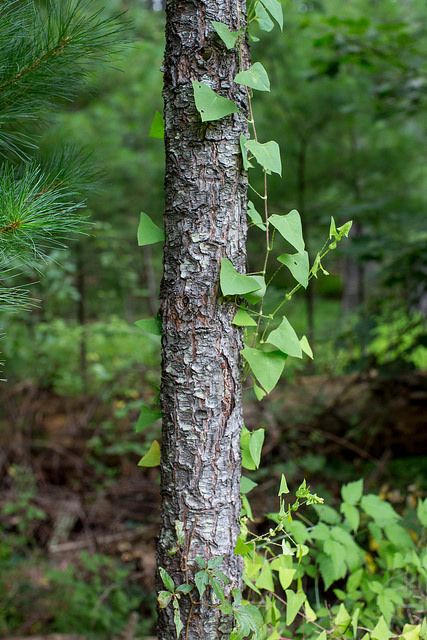Invasive Species Experts work to stop the clock on Mile-A-Minute in the Catskills and look to the public for aid
New Mile-A-Minute Infestations have been found in Woodstock, New York
ARKVILLE, NY, August, 31, 2017 — The Catskill Mountains, one of the most unique landscapes in New York State, are un- der threat from an aggressively invasive plant that could diminish the stream and forest habitats that the Catskills are so well known for.
Mile-a-minute is widespread in the lower Hudson Valley, but these are only the second and third populations that we know about in the Catskill region, with the other infestation along the Delaware River.
Now is the time to look for this plant. It is growing vigorously over other plants and is currently in flower and fruit, which makes it easier to recognize. CRISP is hoping that Catskill visitors and property owners will help to find and remove this plant.
Mile-a-minute vines have alternate, 4-7 cm long and 5-9 cm wide, light green triangular leaves. The vines are light green and become reddish as they mature. The vine stems and the undersides of leaves are covered with recurved barbs that help it to hold onto objects and climb. A unique feature of mile-a-minute is that it has 1-2 cm diameter round, flat leaves, called "ocreae," that encircle the stems at the nodes. The green fruits become blue when ripe.
Mile-a-minute is a highly invasive, herbaceous annual vine native to eastern Asia. It was unintentionally introduced in contaminated soil into the United States in Pennsylvania and Maryland in the 1930’s. It is an aggressive invader, earning its common name by its fast growth. The plant can grow up to six inches a day.
It grows as a vine, using its spines to hold and climb over other plants. It reproduces by seed and Mile-a-Minute weed is a prolific seeder. The plant flowers from late summer through October and can produce many fruit during one sea- son. Vines are killed by fall frost, but the seeds overwinter in the soil. Seeds can be viable in the soil for up to 6 years and germinate at a high rate.
Mile-a-minute colonizes disturbed areas of full sun and moist soils, along stream banks, wetlands, roadsides and in old fields. Mile-a-minute outcompetes native species by its rapid growth and ability to grow over other plants and shade them out. Its seeds can float and they can be carried downstream, which aids the spread of this plant to previ- ously uninfested areas. The main vector for seed dispersal are birds that eat the fruits and deposit the seeds in their droppings, as do mammals such as deer, chipmunks and squirrels. Recent research has found that ants may also move seeds.
Please report any observations of this plant at http://catskillcenter.org/mileaminute. If you are willing to help us survey for this plant, or if you would like us to survey your property for this plant, please reach out via this link: http:// catskillcenter.org/mileaminute
###
ABOUT THE CATSKILL CENTER
Since 1969, the Catskill Center has led the effort to protect the more than 700,000 acres of the Catskill Park and Catskill Forest Preserve. We are the major force advocating for the Catskill region.
Our Mission is to protect and foster the environmental, cultural and economic well-being of the Catskill Region


